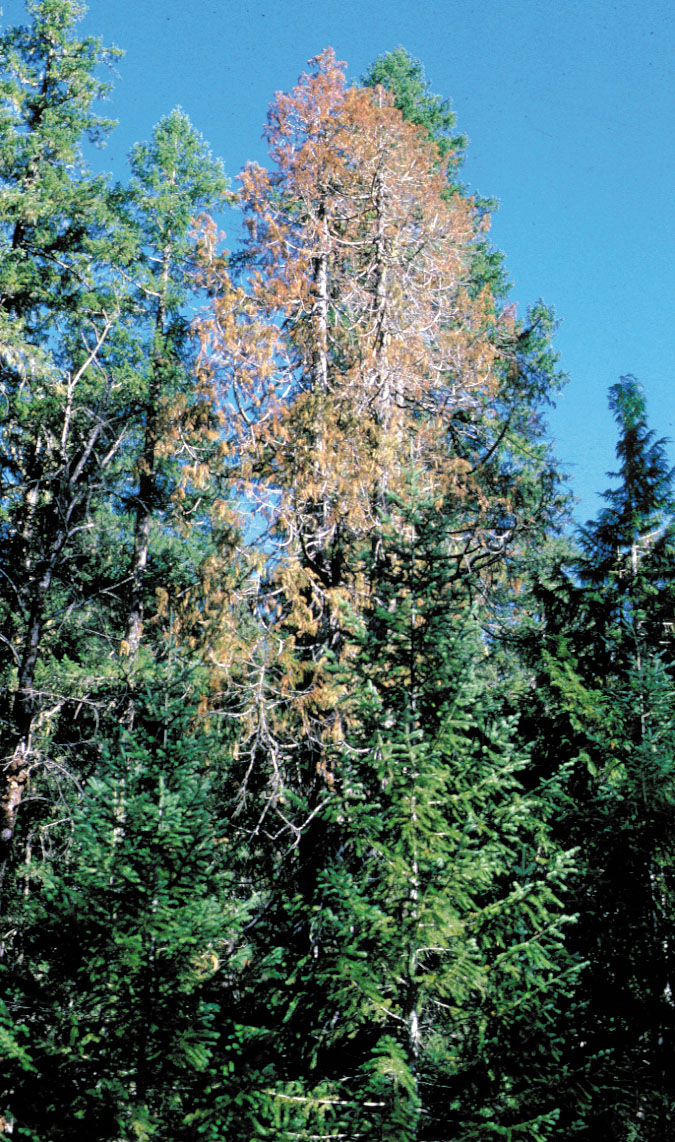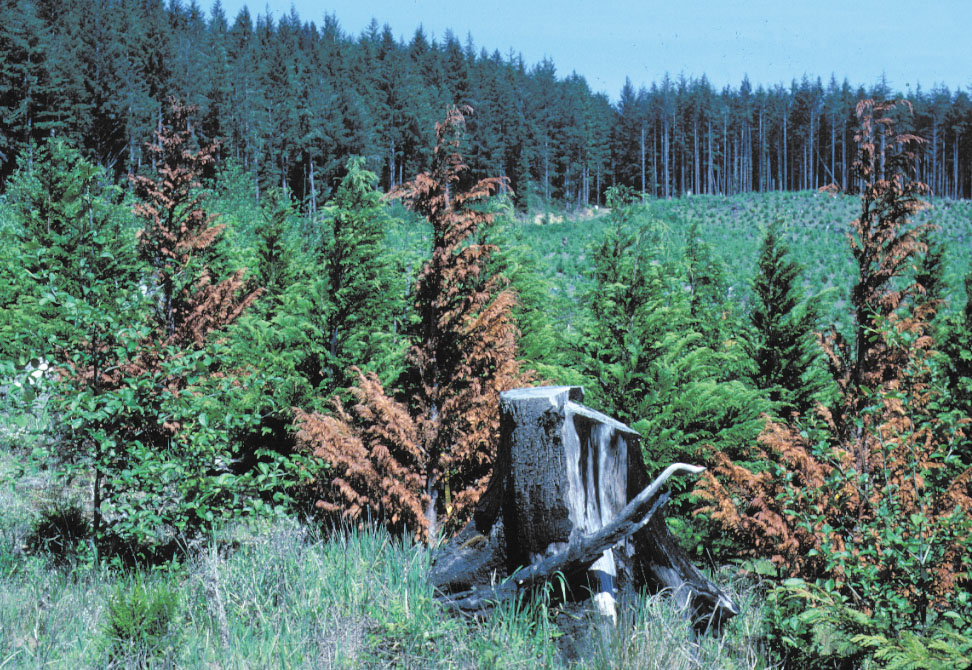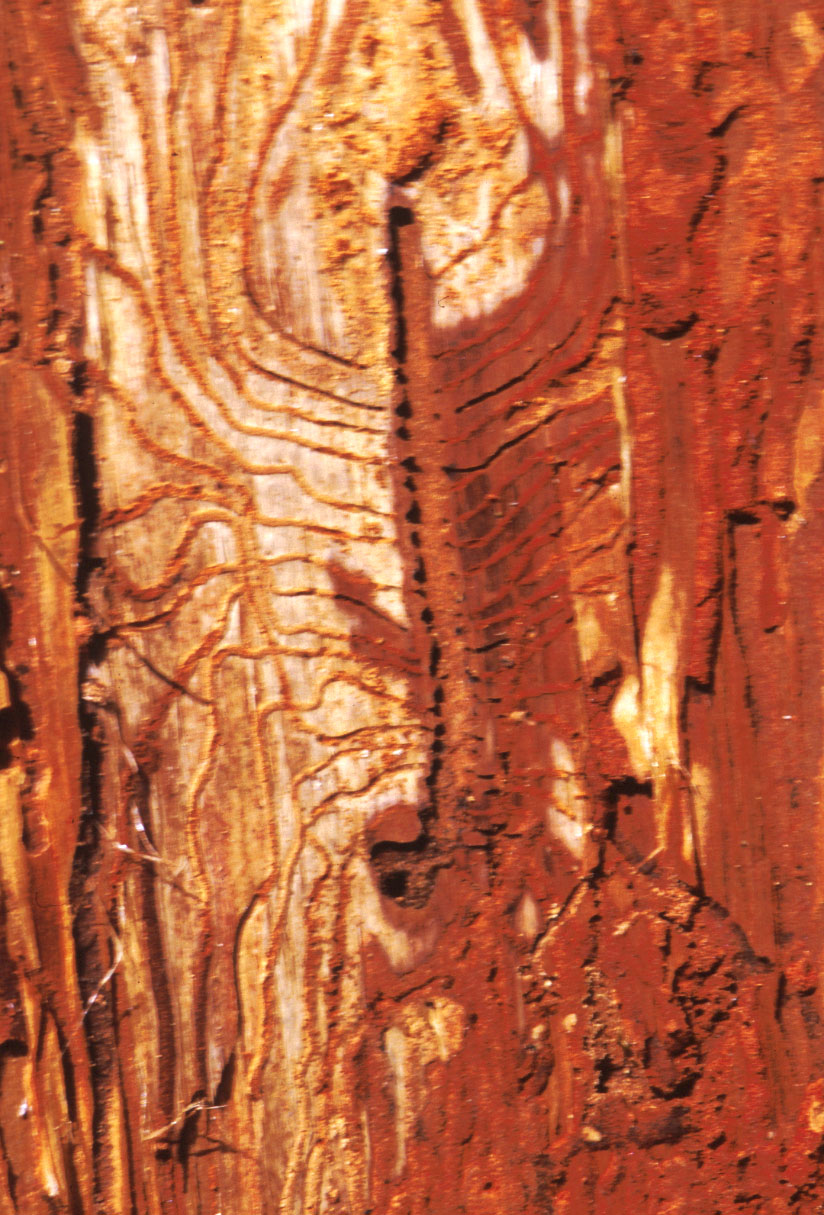Port-Orford-Cedar Root Disease
Phytophthora lateralis
Key Wildlife Value:
Phytophthora lateralis creates all sizes of short-term snags and long lasting down wood by killing Port-Orford-cedar trees and weakening their root systems. A high proportion of the dead wood created by this pathogen occurs in riparian areas. Although there is strong evidence that Port-Orford-cedar snags are little used for cavity excavation, it is thought that the snags that fall into and over streams provide valuable, durable habitat for fish and other aquatic and riparian-associated organisms.
Distribution in Oregon and Washington:
Restricted in native forests to coastal areas in southwestern Oregon; also present in ornamental plantings west of the Cascades in Oregon and Washington. (See also Important Habitats and Spread Dynamics).
Hosts:
Port-Orford-cedar and occasionally Pacific yew growing in close proximity to infected Port-Orford-cedar trees.
Diagnosis:
Foliage discoloration provides the first external indicator of infection by P. lateralis.


One of the best diagnostic signs of P. lateralis may be found under the bark of wilted or yellow trees.

Cedar bark beetles (Phloeosinus spp.) or their galleries are often present in trees infected or killed by Port-Orford-cedar root disease; however they also colonize Port-Orford-cedar trees stressed by other agents, especially drought.

Life History:
The pathogen that causes Port-Orford-cedar root disease is not native to the Pacific Northwest. It was first reported on ornamentals near Seattle, Washington, in 1923. The pathogen responsible for the disease, Phytophthora laterali, was described in1942, but the disease was not found in the native forests of southwestern Oregon until 1952. The pathogen (which is not a fungus but is an Oomycete most closely related to flagellate algae) is a “water mold” that lives and grows in the roots and lower stems of its host trees, survives in a resting state in soil, and actively travels in surface water. It produces four different spore forms, two of which are important in spread: a chlamydospore, which is a resting spore, and a zoospore, which can swim short distances in water and can infect new hosts. P. lateralis enters new host trees through uninjured root tips (via zoospores) and through mycelial growth across grafted roots. As the fungus grows within the tree it advances through the roots and up the lower bole, extending up the trunk not much farther than a distance of about twice the stem diameter before the crown dies and tissues dry. Chlamydospores are produced in infected roots. As dead roots deteriorate, these spores are released into the soil, where they may survive in the absence of free water for up to 6 years. With the onset of cool, wet weather, chlamydospores germinate and produce zoospores. Zoospores, which are produced both on mycelium in infected roots and by chlamydospores, are released when the soil becomes saturated with water. These motile spores cannot live in dry soil and are totally dependent upon water for survival and transport. Port-Orford-cedar root tips release chemicals that attract zoospores and stimulate their germination.
No immunity to P. lateralis has been discovered in the Port-Orford-cedar population, although a number of more resistant individuals have been identified. An active program is underway to identify additional resistant individuals and breed for enhanced resistance.
Important Habitats and Spread Dynamics:
Favorable habitat for Port-Orford-cedar root disease is provided within the range of Port-Orford-cedar on low-lying wet areas, including streams, ditches, swamps, seeps, ponds, or lakes, located downslope from infested areas, roads, or other likely sites of introduction. High risk areas extend from 25 feet above a road to 50 feet below, and on 50 feet either side of streams located downslope of roads and infested areas.
P. lateralis spreads via primarily via soil and water. It can spread short or long distances by means of zoospores. Zoospores are spread mostly downslope or downstream in water moved by gravity. Spread via zoospores is more likely on flat areas, broad, gentle slopes, or concave sites where water stands or spreads out to slowly percolate through the soil. Convex slopes and steep drainages quickly channel water into streams, restricting spread across the upland portions of the slopes.
P. lateralis also is spread in soil containing chlamydospores. Soil-spread usually requires a vector. Although wildlife and livestock can transport the fungus when infested soil sticks to their feet, humans have been the primary vector of Port-Orford-cedar root disease. Humans have spread the disease by moving infected seedlings and soil into uninfected areas, but major spread of the disease has resulted from soil transport on tires and machinery during road building, logging, traffic flow, or recreational activities.
Although capable of slowly spreading via root grafts, moving at a rate of about 15 cm (6 in) per year, this mode of spread is significant only in dense stands of Port-Orford-cedar where roots are closely associated.
Although high levels of Port-Orford-cedar mortality have occurred on suitable sites, on dry sites the levels of mortality have been lower or altogether absent. Port-Orford-cedar regenerates profusely from surviving trees. Significant mortality in mature riparian stands with a high component of Port-Orford-cedar has resulted in stand structures shifting toward increased proportions of smaller trees. Abundant recurring Port-Orford-cedar regeneration on high-risk sites may maintain chronic sources of this disease.
Opportunities for Manipulation to Increase Wildlife Habitat:
No opportunities exist for manipulation of Port-Orford-cedar root disease to increase wildlife habitat. Because P. lateralis is a non-native, introduced species, it would be highly undesirable to encourage its activity in native ecosystems. Effects of P. lateralis upon wildlife habitat have not been studied, and although short-term impacts may be beneficial to some wildlife in some locations, its long-term impacts to native ecosystems are believed to be quite detrimental.
Potential Adverse Effects:
Extensive mortality of Port-Orford-cedar may occur on sites infected with P. lateralis. Mortality is likely to be especially severe in riparian and low-gradient wet areas, and along roadsides. Riparian stand structures may be permanently altered to smaller trees, providing reduced shading and future large wood input. Large stand structure on sites with ultramafic (serpentine) soils where Port-Orford-cedar is the only tree species capable of growing may be permanently lost.
Screening, shading, aesthetic values, and public safety may be negatively affected when trees on developed sites are killed by Port-Orford-cedar root disease.
How to Minimize the Risk of Adverse Effects:
Protect uninfected stands by aggressive management to prevent movement of infested water or soil to uninfested sites. Strategies include road closures, operation restrictions, requirements and wash stations to clean vehicles and equipment before entering and leaving specified areas, and berm construction along roadsides to reduce vehicle splash and road runoff into adjacent susceptible forests. Where Port-Orford-cedar populations along a susceptible roadway could act as a bridge for the pathogen to uninfected areas, creation of a non-host buffer along the road by removing all Port-Orford-cedars within a specified distance can minimize spread. In some situations, infected sites could be kept free of all Port-Orford-cedars until the inoculum dies.
References
Betlejewski, F., D.J. Goheen, P.A. Angwin, and R.A. Sniezko. 2011.Port-Orford-cedar root disease. Forest Insect and Disease Leaflet 131 (revised). USDA Forest Service, Portland, OR. 12 pp.
Goheen, E.M. and E.A. Willhite. 2006. Field guide to common diseases and insect pests of Oregon and Washington conifers. USDA Forest Service, Pacific Northwest Region, Portland, OR. R6-NR-FID-PR-01-06. 335 pp. http://www.biodiversitylibrary.org/bibliography/80321#/summary
Roth, L.F., R.D. Harvey, and J.T. Kliejunas. 1987. Port-Orford-cedar root disease. USDA Forest Service, Pacific Northwest Region, R6-FPM-PR-010-91. 11 pp.
Website links
Western Forest Insects and Diseases: Publications and Links
Forest Insect and Disease Leaflets - Port-Orford-Cedar Root Disease